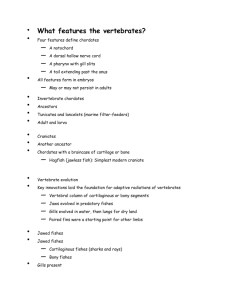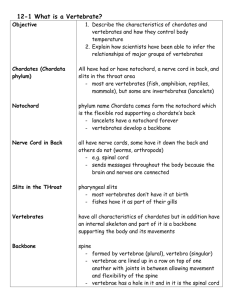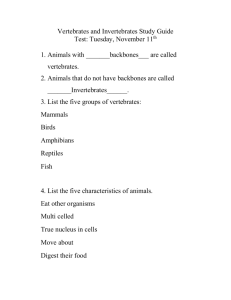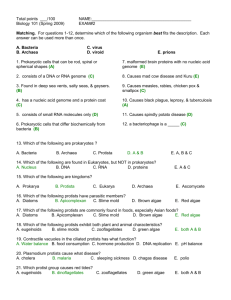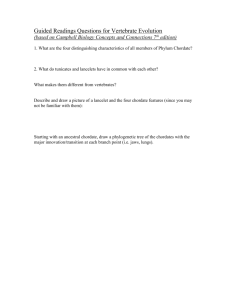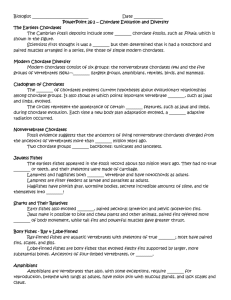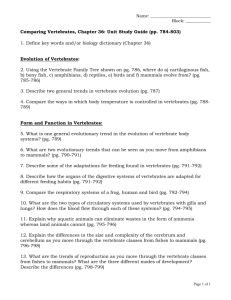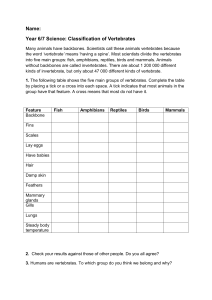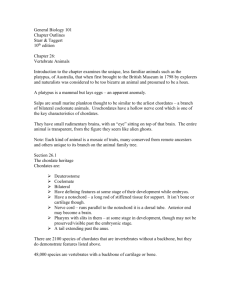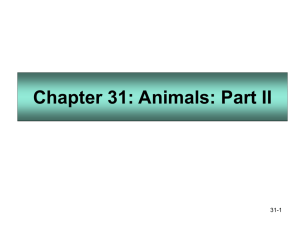CHAPTER OUTLINE
advertisement
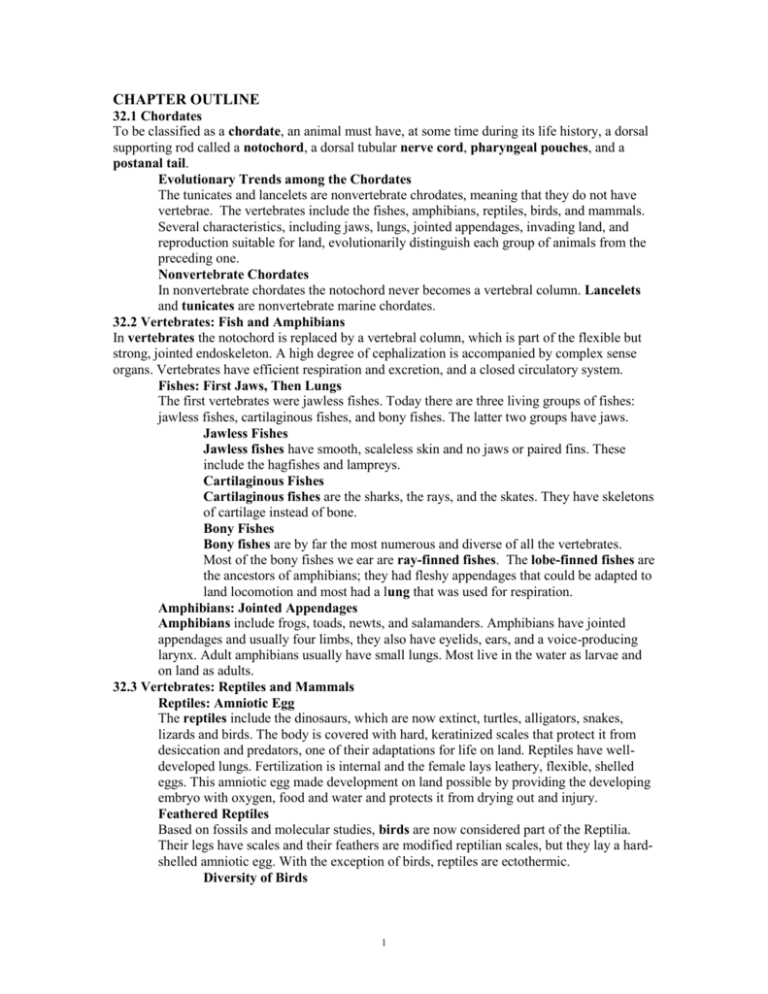
CHAPTER OUTLINE 32.1 Chordates To be classified as a chordate, an animal must have, at some time during its life history, a dorsal supporting rod called a notochord, a dorsal tubular nerve cord, pharyngeal pouches, and a postanal tail. Evolutionary Trends among the Chordates The tunicates and lancelets are nonvertebrate chrodates, meaning that they do not have vertebrae. The vertebrates include the fishes, amphibians, reptiles, birds, and mammals. Several characteristics, including jaws, lungs, jointed appendages, invading land, and reproduction suitable for land, evolutionarily distinguish each group of animals from the preceding one. Nonvertebrate Chordates In nonvertebrate chordates the notochord never becomes a vertebral column. Lancelets and tunicates are nonvertebrate marine chordates. 32.2 Vertebrates: Fish and Amphibians In vertebrates the notochord is replaced by a vertebral column, which is part of the flexible but strong, jointed endoskeleton. A high degree of cephalization is accompanied by complex sense organs. Vertebrates have efficient respiration and excretion, and a closed circulatory system. Fishes: First Jaws, Then Lungs The first vertebrates were jawless fishes. Today there are three living groups of fishes: jawless fishes, cartilaginous fishes, and bony fishes. The latter two groups have jaws. Jawless Fishes Jawless fishes have smooth, scaleless skin and no jaws or paired fins. These include the hagfishes and lampreys. Cartilaginous Fishes Cartilaginous fishes are the sharks, the rays, and the skates. They have skeletons of cartilage instead of bone. Bony Fishes Bony fishes are by far the most numerous and diverse of all the vertebrates. Most of the bony fishes we ear are ray-finned fishes. The lobe-finned fishes are the ancestors of amphibians; they had fleshy appendages that could be adapted to land locomotion and most had a lung that was used for respiration. Amphibians: Jointed Appendages Amphibians include frogs, toads, newts, and salamanders. Amphibians have jointed appendages and usually four limbs, they also have eyelids, ears, and a voice-producing larynx. Adult amphibians usually have small lungs. Most live in the water as larvae and on land as adults. 32.3 Vertebrates: Reptiles and Mammals Reptiles: Amniotic Egg The reptiles include the dinosaurs, which are now extinct, turtles, alligators, snakes, lizards and birds. The body is covered with hard, keratinized scales that protect it from desiccation and predators, one of their adaptations for life on land. Reptiles have welldeveloped lungs. Fertilization is internal and the female lays leathery, flexible, shelled eggs. This amniotic egg made development on land possible by providing the developing embryo with oxygen, food and water and protects it from drying out and injury. Feathered Reptiles Based on fossils and molecular studies, birds are now considered part of the Reptilia. Their legs have scales and their feathers are modified reptilian scales, but they lay a hardshelled amniotic egg. With the exception of birds, reptiles are ectothermic. Diversity of Birds 1 The majority of birds are able to fly. Some are flightless. Traditionally they have been classified based on beak and foot type and, to some extent, on their habitat and behavior. Anatomy and Physiology of Birds Nearly every anatomical feature of a bird can be related to its ability to fly. Birds have a four-chambered heart and are endothermic. Mammals: Hair and Mammary Glands Mammals evolved from the reptiles. The chief characteristics are body hair and milkproducing mammary glands. Monotremes Monotremes are mammals that have a cloaca, a common chamber for feces, excretory wastes, and sex cells. They lay hard-shelled amniotic eggs. They are represented by only five species: four spiny anteaters and the duckbill platypus. Marsupials The young of marsupials begin their development inside the female’s body, but they are born in a very immature condition. Newborns crawl up into a pouch on their mother’s abdomen, attach to the nipples of mammary glands, and continue to develop. They are found mainly in Australia and include koalas and kangaroos. Placental Mammals The vast majority of living mammals are placental mammals. The extraembryonic membranes have been modified for internal development within the uterus of the female. With the exception of marine mammals, mammals are adapted to life on land. The mammalian brain is well-developed and enlarged due to the expansion of the cerebral hemispheres. Mammals also have differentiated teeth. Primates Primata are members of the order Primates. They are adapted to an arboreal life (living in trees). Primate limbs are mobile, and the hands and feet both have five digits each. The evolutionary trend among primates is toward a larger and more complex brain. One offspring per birth interval is the norm. Primates has two suborders: the strepsirhini (lemurs, aye ayes, bush babies, and lorises) and the haplorhini (monkeys, ape, and humans). 32.4 Evolution of the Hominins All primates share a common ancestor and over time they diverged, producing various lineages. Humans are most closely related to African apes, but the two lineages split about 6 to 8 MYA according to molecular data. Currently, humans and chimpanzees are probably the most closely related, sharing more than 90% of our DNA. Hominins include humans and species very closely related to humans and evolved about 5 MYA. Hominins, chimpanzees, and gorillas are now grouped together as hominines. The hominids include the hominines and the oranguatan. The hominoids include the gibbon and the hominids. Evolution of Humanlike Hominins The biggest derived characteristic that separates modern humans is bipedalism, an anatomy suitable for standing erect and walking on two feet. Australopithecines Australopithecus anamensis, a fossil discovered in Middle Awash, Ethiopia, may be the missing evolutionary link between Ardipithecus and the australopithecines, the possible direct hominin ancestors for humans. Evolution of Early Homo 2 Early Homo species appear in the fossil record approximately 2 MYA, they all have a brain size that is 600 cc or greater, their jaw and teeth resemble those of humans, and tool use is in evidence. Homo habilis and Homo rudolfensis H. habilis is credited as being the first members of the genus to use tools. H. habilis and H. rudolfensis were socially organized, probably scavengers, had smaller cheek teeth, and were omnivorous. Their face protruded less and their brains were larger than australopiths. Homo ergaster and Homo erectus Compared to H. habilis, H. ergaster had a larger brain, rounder jaw, prominent brow ridges, and a projecting nose. Most likely H. erectus evolved from H. ergaster after H. ergaster arrived in Asia. They had a knowledge of fire and may have been the first to cook meat. Homo floresiensis It appears that H. floresiensis coexisted with modern H. sapiens and used tools and fire. 32.5 Evolution of Modern Humans The most widely accepted hypothesis for the evolution of modern humans from archaic humans is referred to as the replacement model, or out-of-Africa hypothesis, which proposes that modern humans evolved only in Africa and then migrated to Asia and Europe. This is supported by the fossil record and DNA data. The opposing multiregional continuity hypothesis proposes that modern humans arose from archaic humans in essentially the same manner in Africa, Asia, and Europe. Neandertals The Neandertal brain was slightly larger than that of Homo sapiens. They had massive brow ridges, wide, flat noses, a forward-sloping forehead and a receding lower jaw. Evidence suggests that Neandertals were culturally advanced. Cro-Magnon Cro-Magnons are the oldest fossils to be designated Homo sapiens. They had lighter bones, high foreheads, domed skulls, small teeth, and a distinct chin. They hunted cooperatively and may have been the first to have language and their culture included art. 3
